Ultra Violet Buddleia, Oakland Holly, and Dwarf Alberta Spruce tree stand out as ideal companions for the Gold Mop Cypress. These plants not only share compatible growth requirements but also create a visually appealing ensemble in your garden.
Gold Mop Cypress, with its distinctive golden foliage, adds a touch of elegance to any garden landscape. This hardy evergreen shrub is not only prized for its aesthetic appeal but also for its versatility. One key aspect of cultivating a thriving garden is selecting suitable companion plants to complement the Gold Mop Cypress. In this comprehensive guide, we will explore the ideal companions, delve into the nuances of planting and caring for Gold Mop Cypress, and address common queries regarding its growth and maintenance.
Gold Mop Cypress Companion Plants
Ultra Violet Buddleia, Oakland Holly, and Dwarf Alberta Spruce tree stand out as ideal companions for the Gold Mop Cypress. These plants not only share compatible growth requirements but also create a visually appealing ensemble in your garden.
1. Ultra Violet Buddleia
Ultra Violet Buddleia, also known as the Butterfly Bush, serves as a splendid companion for Gold Mop Cypress. This deciduous shrub, known for its vibrant purple flowers, adds a burst of color to your garden. Planting Ultra Violet Buddleia near Gold Mop Cypress creates a striking contrast between the rich golden hues and the bold purples, enhancing the overall aesthetic appeal. Ensure proper spacing to allow both plants to flourish without competing for resources.
Buy now – Check Price in
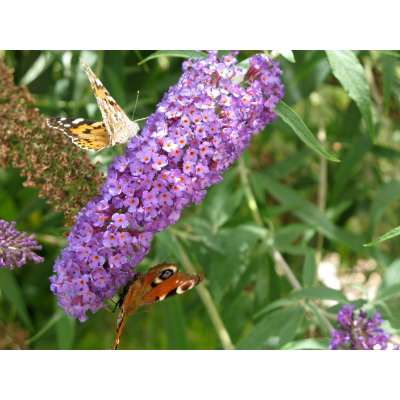
More Options : for cypress trees-
2. Oakland Holly
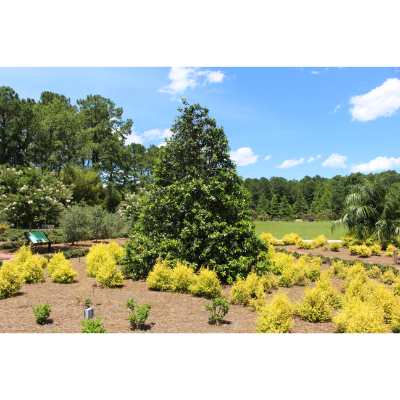
Oakland Holly, with its glossy green leaves and bright red berries, complements the Gold Mop Cypress beautifully. These evergreen shrubs not only provide year-round visual interest but also create a dynamic play of colors. When strategically placed, Oakland Holly enhances the backdrop of Gold Mop Cypress, creating a visually pleasing and balanced composition. Consider the sunlight requirements of both plants to ensure they thrive together in harmony.
3. Maidenhair fern (Adiantum pedatum)
This fern has over 199+ sorts inside the international and it has fan-formed foliage that is green and attractive. It has small fronds that are interesting and provides splendor to any landscape. Generally they will be grown outdoor really beneath a cover of wood which offers them partial color slight that is first-rate for them.
Buy now – Check Price in
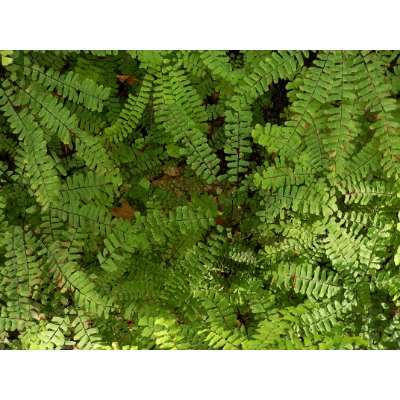
4. Hart’s tongue
It is an evergreen fern plant that grows in USDA region 5-9 and calls for minimal care. They additionally develop under a tree or shrub and are local to North America, Europe and Western part of Asia. It has huge fronds which may be green in shade and it is honestly tongue original. This may be grown with gold mop cypress with out trouble. It may be grown in well drained and properly wet soil. It can become a extremely good partner plant for our gold mop cypress
Buy now – Check Price in
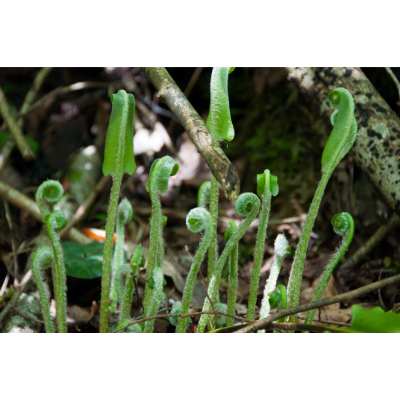
5. Periwinkle
Incorporating periwinkle into your garden design alongside Gold Mop Cypress introduces a delightful array of blue and violet shades. Periwinkle, also known as Vinca minor, is a low-growing ground cover that complements the vertical growth of Gold Mop Cypress. This combination not only enhances the visual appeal but also contributes to a well-integrated garden ecosystem. Consider the growth patterns of both plants to achieve a harmonious balance between ground covers and upright shrubs.
Buy now – Check Price in
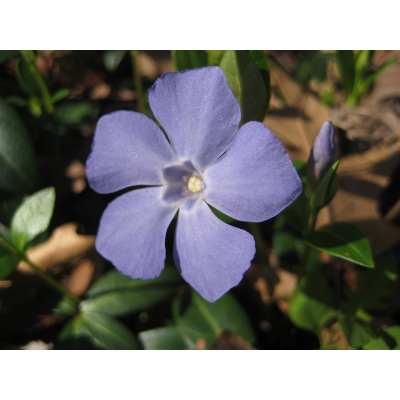
6. Alberta Spruce tree
For those looking to add vertical interest to their garden, the Dwarf Alberta Spruce tree is an excellent choice alongside Gold Mop Cypress. These compact evergreen trees maintain a manageable size, making them suitable for smaller gardens. Planting Dwarf Alberta Spruce strategically around Gold Mop Cypress adds depth and structure to the landscape. Pay attention to the height considerations of both plants to achieve a well-balanced and visually appealing garden design.
Buy now – Check Price in
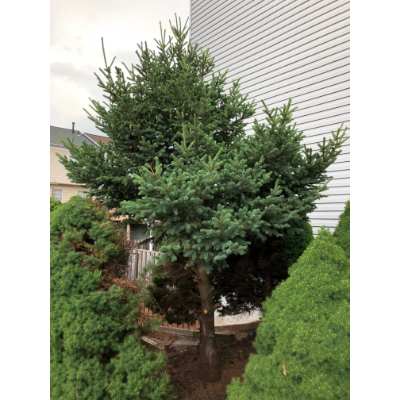
7. San Jose juniper shrubs
San Jose Juniper shrubs, with their unique texture and form, make for an interesting pairing with Gold Mop Cypress. These evergreen shrubs offer a contrast in foliage that adds visual interest to the garden. When strategically placed, San Jose Juniper shrubs create a textured backdrop for the golden mop-like foliage of the Cypress. Consider the maintenance requirements of both plants to ensure a cohesive and well-manicured landscape.
Buy now – Check Price in
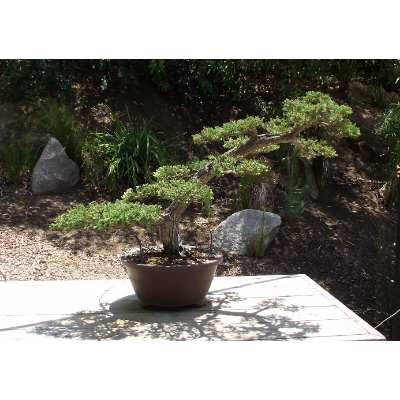
8. Japanese Blueberry
These also are one among such evergreen bushes that desires minimal protection and the peak it holds is ready 60 toes while grown fully. It has very vibrant green foliage and once leaves start to mature it will become orange/crimson/red in colour and drops off from the tree. Every season it continues thriving and it appears appealing additionally.
It was popular in Japan and China in which this changed into at the beginning born.
9. Japanese Cedar Tree
Best with the combination of gold mop cypress as this becomes a pyramid in shape with a lot inexperienced foliage. This tree is stated to stay upto 600 years long, and a main enchantment is its blue inexperienced suggestions on stems proven. The real excessive might be over one hundred ft & may spread to 30 feet.
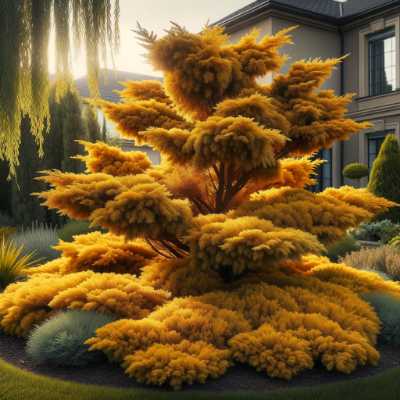
10. Lavandula Spp
Lavandula Spp, commonly known as lavender, adds fragrance and color harmony when paired with Gold Mop Cypress. The aromatic qualities of lavender create a sensory experience in the garden, enhancing the overall ambiance. Planting Lavandula Spp near Gold Mop Cypress not only introduces a delightful scent but also contributes to a visually cohesive landscape. Pay attention to pruning and maintenance to ensure both plants thrive and complement each other effectively.
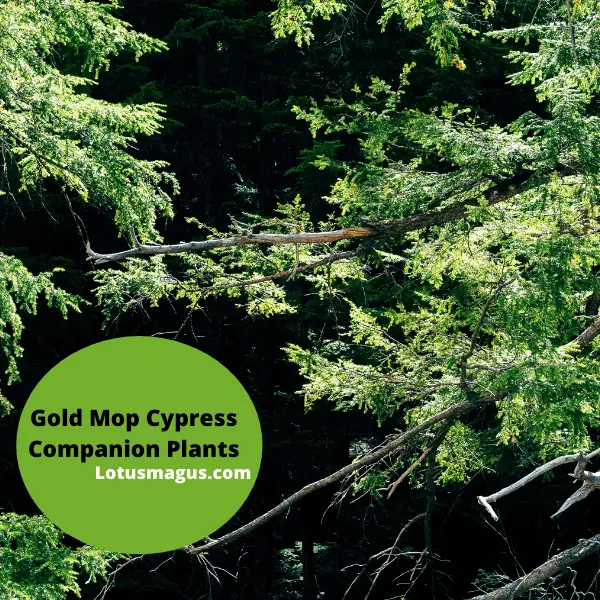
Planting Gold Mop Cypress
Successfully cultivating Gold Mop Cypress requires careful consideration of planting locations, sunlight requirements, and soil preferences. Understanding the optimal conditions for growth is essential to ensure the health and vitality of this distinctive shrub.
Suitable Locations
Gold Mop Cypress thrives in well-drained soil and is adaptable to various soil types. When selecting a location, prioritize areas with good drainage to prevent waterlogged roots. Additionally, consider the sunlight requirements—Gold Mop Cypress generally prefers full sun to partial shade. Planting in a location that receives adequate sunlight promotes vigorous growth and vibrant foliage. Conduct a soil test to assess the pH and nutrient levels, making any necessary amendments to create an optimal growing environment.
Spacing Guidelines
Determining the appropriate spacing for Gold Mop Cypress is crucial for its long-term health and aesthetic impact. These shrubs can spread up to five feet, so maintaining proper spacing ensures they have ample room to grow without overcrowding. Follow the recommended spacing guidelines based on the specific variety of Gold Mop Cypress you have. Providing adequate space between plants facilitates air circulation, reduces the risk of diseases, and allows each shrub to receive sufficient sunlight for optimal growth.
Proximity to Structures
While Gold Mop Cypress can add a touch of greenery near structures, careful consideration is necessary when planting them close to houses or other buildings. Proximity to structures can provide a visually appealing backdrop, but it’s essential to account for the shrub’s mature size. Ensure that the Cypress won’t outgrow its space, potentially causing issues with windows, gutters, or other structures. Consider the potential risks and benefits of planting Gold Mop Cypress near buildings, and plan accordingly to maintain a harmonious and functional landscape.
Gold Mop Cypress: Size and Growth
Understanding the size and growth patterns of Gold Mop Cypress is vital for effective landscape planning. Whether you aim to maintain a compact garden or prefer a more expansive design, knowing how to manage the size of your Gold Mop Cypress is key.
Height Considerations
Gold Mop Cypress can reach varying heights depending on the specific variety and growing conditions. Understanding the expected height of your chosen variety is crucial for planning a well-balanced landscape. Taller varieties may serve as focal points, while shorter ones can be strategically placed to create visual interest at different levels. Consider the overall design goals of your landscape to determine the most suitable height for your Gold Mop Cypress.
Managing Size
If you prefer to keep your Gold Mop Cypress on the smaller side, proactive measures can be taken to manage its size. Regular pruning is an effective technique for controlling the height and shape of the shrub. Begin pruning when the plant is young, focusing on shaping it as it grows. Pay attention to the natural form of the Cypress and trim accordingly to maintain a well-balanced and visually pleasing appearance. Keep in mind that proper pruning not only controls size but also promotes a healthier and more robust plant.
Gold Mop Cypress Varieties
Gold Mop Cypress is available in various varieties, each with its unique characteristics. Understanding the differences between these varieties, such as Golden Mop vs. Lemon Thread, Gold Thread Cypress vs. Gold Mop Cypress, and Dwarf Gold Mop Cypress, allows you to make informed decisions for your garden.
Golden Mop vs. Lemon Thread
Golden Mop and Lemon Thread are two popular varieties of Gold Mop Cypress, each with distinct features. Golden Mop is known for its finely textured golden foliage, while Lemon Thread exhibits a brighter, lemon-yellow color. Consider the color preferences and overall aesthetic goals for your garden when choosing between these varieties. Additionally, factor in the available space and sunlight conditions to ensure the selected variety thrives in its designated location.
Gold Thread Cypress vs. Gold Mop Cypress
Gold Thread Cypress and Gold Mop Cypress are sometimes used interchangeably, but they have subtle differences. Gold Thread Cypress, with its thread-like foliage, offers a unique texture that differs from the mop-like appearance of Gold Mop Cypress. Understanding these differences allows you to make intentional choices when designing your landscape. Consider the texture and visual impact you desire, and select the variety that best complements your overall garden theme.
Dwarf Gold Mop Cypress
For smaller gardens or those looking to create a compact landscape, Dwarf Gold Mop Cypress is a suitable choice. These varieties maintain a manageable size while retaining the distinctive golden foliage characteristic of Gold Mop Cypress. When incorporating Dwarf Gold Mop Cypress into your garden, consider the available space and design goals. Their compact nature makes them versatile for various landscaping styles, and they can be used as focal points or integrated into larger plantings for added visual interest.
Cypress in Gardens
Cypress, including Gold Mop Cypress, is a valuable addition to garden landscapes. Understanding their general suitability, lifespan, and considerations for planting near structures contributes to the successful integration of these evergreen shrubs into your garden.
General Suitability
Cypress, known for its adaptability and resilience, is generally well-suited for garden landscapes. Gold Mop Cypress, in particular, adds a touch of elegance and vibrancy. Its ability to thrive in various soil types and sunlight conditions makes it a versatile choice for different garden styles. Consider the overall design goals of your garden and how Gold Mop Cypress can contribute to a visually appealing and well-integrated landscape.
Lifespan of False Cypress
False Cypress, including Gold Mop Cypress, has a relatively long lifespan when provided with proper care. The average lifespan can range from 20 to 30 years or more, depending on factors such as soil quality, climate, and maintenance practices. Understanding the lifespan of Gold Mop Cypress allows you to plan for its long-term presence in your garden. Consider this longevity when designing your landscape to ensure a sustainable and enduring aesthetic appeal.
Gold Mop Cypress Care
Ensuring the health and vitality of Gold Mop Cypress involves addressing specific care considerations, such as deer resistance, browning issues, and understanding its scientific name and features.
Deer Resistance
Gold Mop Cypress is known for its deer-resistant qualities, making it an excellent choice for landscapes frequented by these browsing animals. While no plant can be completely deer-proof, selecting deer-resistant plants, including Gold Mop Cypress, can help minimize damage. Implement additional strategies, such as installing fencing or using deer-repelling methods, to further protect your garden. By understanding the deer resistance of Gold Mop Cypress, you can create a garden that thrives even in areas with high deer populations.
Browning Issues
Browning of Gold Mop Cypress foliage can occur due to various factors, including environmental stress, diseases, or improper care. Identifying the underlying causes of browning is crucial for implementing effective remedies. Ensure proper watering practices, especially during dry periods, and monitor soil moisture levels. Regularly inspect the foliage for signs of pests or diseases, addressing issues promptly. Proper care, including adequate watering, pruning, and disease management, contributes to maintaining the vibrant golden color of Gold Mop Cypress.
Scientific Insight
Understanding the scientific name of Gold Mop Cypress, which is Chamaecyparis pisifera ‘Golden Mop,’ provides valuable insights into its botanical features. The genus Chamaecyparis encompasses various cypress species, and the specific epithet ‘pisifera’ refers to the species characteristics. ‘Golden Mop’ indicates the cultivar’s distinctive golden foliage. Familiarizing yourself with the scientific name enhances your knowledge of the plant’s taxonomy and facilitates communication with fellow garden enthusiasts and horticulturists.
False Cypress and Pets
For pet owners, the potential toxicity of plants is a crucial consideration. Addressing concerns about the toxicity of False Cypress, including Gold Mop Cypress, ensures the safety and well-being of your furry companions.
Toxicity to Dogs
False Cypress is generally considered non-toxic to dogs, making Gold Mop Cypress a safe choice for households with canine companions. However, it’s essential to remain vigilant and monitor your pets’ behavior around plants. While Gold Mop Cypress poses minimal risk, some dogs may exhibit sensitivity to certain plants. If you observe any adverse reactions, such as gastrointestinal upset or allergic symptoms, consult with a veterinarian. Creating a pet-friendly garden includes selecting plants like Gold Mop Cypress that pose minimal risks to your four-legged friends.
Sun or Shade Preferences
Understanding the sunlight preferences of Gold Mop Cypress is essential for its overall health and vitality. Whether your garden receives ample sunlight or features shaded areas, adapting to these conditions ensures the optimal growth of Gold Mop Cypress.
False Cypress and Sunlight
Gold Mop Cypress generally prefers full sun to partial shade. Planting in a location that receives at least six hours of sunlight daily promotes healthy growth and vibrant foliage. While Gold Mop Cypress can tolerate partial shade, providing ample sunlight enhances its color intensity and overall appearance. Consider the sunlight conditions in your garden when selecting the planting locations for Gold Mop Cypress to ensure it thrives in its chosen environment.
Adapting to Shade
While Gold Mop Cypress prefers sunlight, it can adapt to partial shade conditions. When planting in shaded areas, be mindful of potential competition for sunlight from surrounding plants. Ensure proper spacing and consider the growth patterns of neighboring vegetation to create a well-balanced environment. Adequate air circulation and attention to soil moisture levels are crucial in shaded areas to prevent issues such as fungal diseases. By understanding the adaptability of Gold Mop Cypress to different light conditions, you can make informed decisions when planning your garden layout.
Conclusion
In conclusion, Gold Mop Cypress is a versatile and visually stunning addition to garden landscapes. Selecting suitable companion plants, understanding optimal planting conditions, managing size, and addressing care considerations contribute to a thriving and aesthetically pleasing garden. Whether you are a seasoned gardener or a novice enthusiast, integrating Gold Mop Cypress into your landscape provides an opportunity to create a dynamic and vibrant outdoor space. By following the guidelines and insights provided in this comprehensive guide, you can cultivate a garden that showcases the beauty and resilience of Gold Mop Cypress while creating a harmonious and inviting atmosphere.
Related Posts:
Gold Mop Cypress: A Deer-Resistant Landscaping Solution
Gold Thread Cypress vs Gold Mop Cypress: Which is Right for You?
How to Trim Overgrown Gold Thread Cypress – Keeping Shape
Golden Mop Cypress Size – How Big Does It Grow
Golden Mop Cypress Turning Brown
Dwarf Gold Mop Cypress – Info, Care Guide
Golden Mop False Cypress : Info on Golden Mop Shrubs
Gold Mop Cypress Pruning – Cutting Small to Medium Sized Trees
Check – How to Care for Gold Mop Cypress
For Trimming Check – How to prune Gold Mop Cypress?
